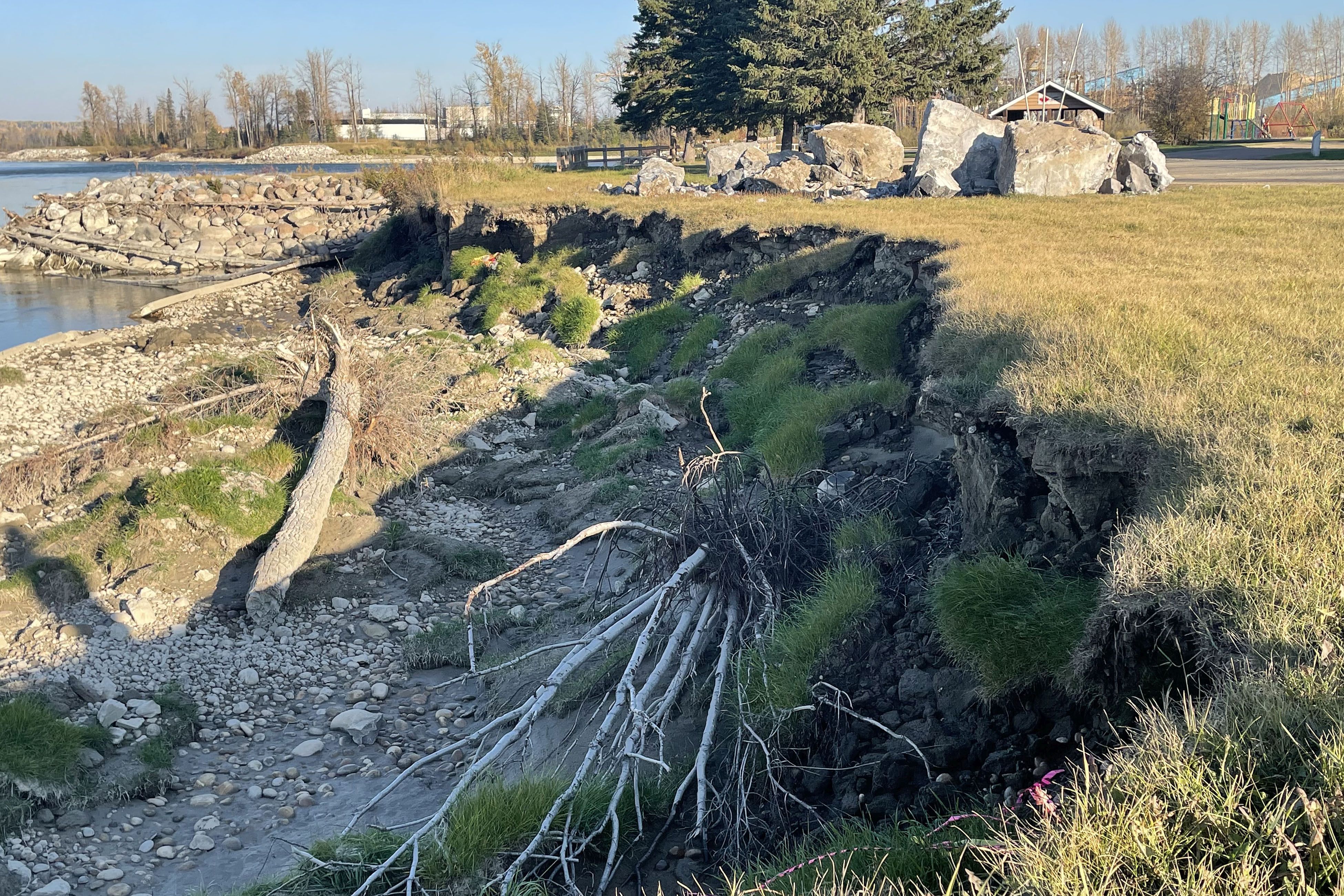
High water flows along Riverboat Park have caused significant erosion. How to fix the issue was a topic during a recent Town of Whitecourt Council meeting. Town CAO Peter Smyl explained. “Some higher waters in late spring, early summer resulted in some erosion. Erosion has been happening in that area for quite some time. There was an area that was, from June 29 to July 6, on the high water marks when we had the campground on standby for evacuation. We noticed the erosion happening in the areas between the two spurs.”
In the 73 years between 1909 and 1982, the bank moved 130m, at an average of 1.8m/year. However, from April 2022 to June 29, 2022, a mere couple of months, the bank moved four metres. When averaged out, that would equate to 24m/year. Then, in eight days (June 29-July 6), the bank moved 6.4 metres, nearly reaching the rate of one metre per day.
Smyl said something needed to happen to prepare for the potential of more high flow rate in the spring. Large rocks left over from the spur project in 2016, which support the spurs against the river’s power, were a perfect fit. “We do have rocks to go along the bank. We tendered that out for the placement and transportation of the rocks to the park site.”
With the tender process complete, Council was provided options from several companies. “We did get some good bids. Timing is of the essence, so the timing does work out now over the next few weeks to get it done. The approvals through provincial and federal are in place, and as it happens, for the park, there is a cost-sharing component that will be cost-shared with our partners,” explained Smyl.
He added that grant applications are part of the process as they seek government funding to help pay the project’s cost. “We are pursuing that side of it. It gives us the opportunity to repair it now. The biggest part of this project is getting the approval. It is nice that the water has rescinded so that we won’t be working in the water. It makes it easier and (needs) less requirements for approvals of testing for turbulence.”
Though the rocks being used were left over from the 2016 spur project, Smyl said they were looking at additional grants to replace the used rocks. He said that the rocks would have eventually been used. “Those rocks will be used from time to time for repairs on the spurs. They are Class 2 rocks, so they are difficult to haul, and we are looking at some options for their replacement in the future.”
Placing the rocks in and supporting the bank varied in cost between the companies seeking the project from just over a hundred thousand dollars to over two hundred and fifty thousand dollars. Administration recommended awarding it to Roszko Construction at the price of $105,580. There is also an added cost of $37,420 for engineering, site restoration and fencing. Administration sought a budget of $143,000 for 2022, with $112,398 coming from the Roads Infrastructure Reserve. Council approved the budget and awarded the contract to Roszko Construction, with work taking place through October.
In previous years, getting approval through Oceans and Fisheries was challenging due to extended waiting periods and the need to work within the water. “As soon as the incident happened, we were after Oceans and Fisheries and the regulatory approval authorities for approval. With the water lowered, we are not working in the river itself, which actually saves us a process for monitoring right now,” explained Smyl.
The high rate of erosion at Riverboat Park is likely due to high river flows, but the RFD (Request for Decision) provided in the meeting showed that the river bank had shifted on the north side (opposite side as the park), directing the main flow of the river directly towards the south bank (the park’s side) rather than paralleling it as it did before. If the shift on the other side of the river continues, the erosion happening at Riverboat Park will grow and extend further. The RFD indicated that further deterioration could result in losing access to the spurs, boat launch, and picnic shelter. The pavilion is closest to the erosion and would likely be lost. Decline continuing would eventually shift the river further and bring the full strength of the Athabasca toward Mill Western’s site. A solution is a necessity.
Smyl stated that getting rock along the bank should work well to protect the land, but continued monitoring would occur, especially after every high flow event for all twelve spurs. Access to Riverboat Park may be obstructed during the project. Residents are reminded to obey construction/work signs.







More Stories
Birthday party chaos sung beautifully by Pumpjack Players’ youth in spring musical
Gearing up for another season of cars, cruising and camaraderie
Big dreams lead a talented local youth to Nashville